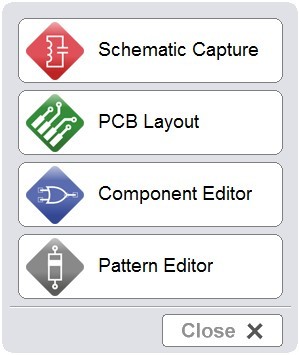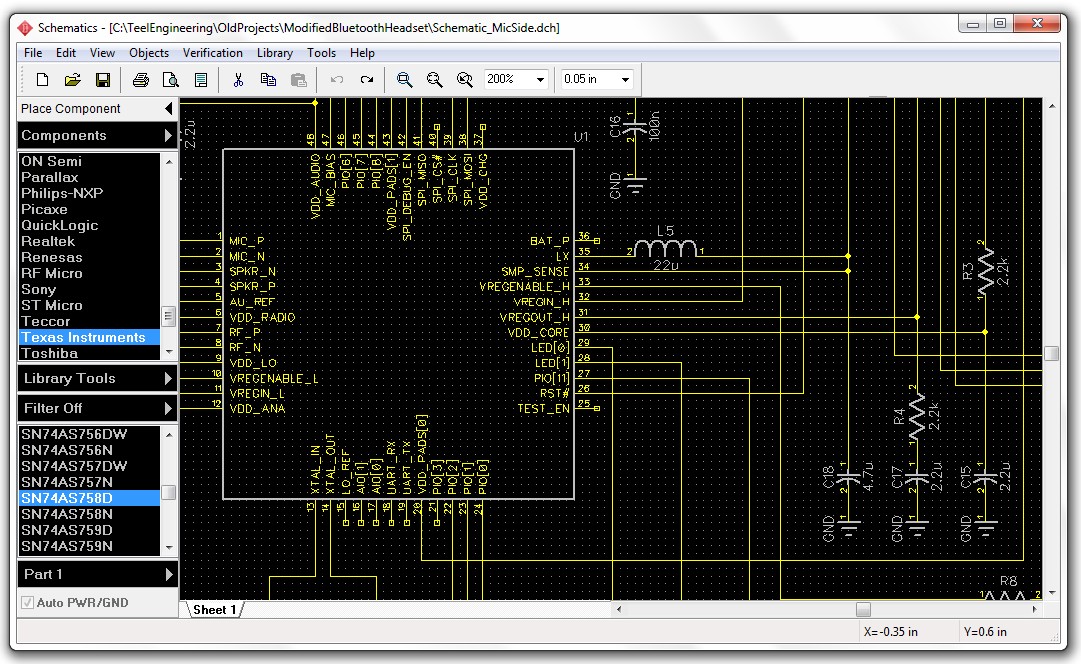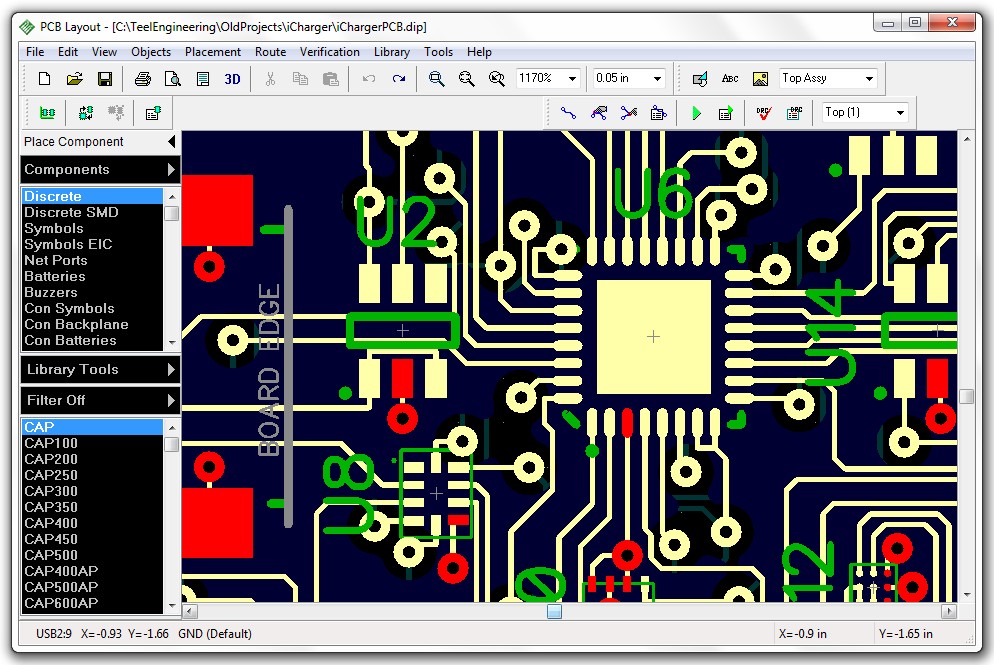Eda Tools For Pcb Design
Learn how to select the best PCB Design Software for your tech product. The pros and cons of using Altium, Eagle, or DipTrace are discussed.

Article Technical Rating: 7 out of 10
There are numerous software packages available for designing printed circuit boards (PCBs), too many in fact. That being said, there are three PCB design packages that tend to be the most popular and considered the best: Altium Designer, Eagle, and OrCad.
However, for hardware entrepreneurs, startups and makers I prefer a less well-known PCB design packaged called DipTrace.
Disclaimer: This article is not intended to be an unbiased review of every PCB design package available. There are many packages not discussed in this article because I've never personally used them. Instead, I wrote this article to share my own experiences. Although I'm a biased fan of DipTrace, you'll learn it's not the best option for everyone.
Altium Designer is considered the Ferrari of PCB design packages and starts at over $7,000! No that is not a typo. It's good software, but that's pretty crazy.
Altium is the most popular PCB design package among those with a company's budget behind them. Because of that it's also the package that many new freelance engineers are most familiar. A good amount of freelancers splurge on Altium because it's what they already know.
Most people developing PCBs independently, like entrepreneurs, hackers, and freelance designers, usually can't afford to shell out that kind of cash on software.
Although significantly cheaper than Altium, OrCad is still really expensive with a price tag of $2,300.
Eagle has changed their payment structure to a recurring fee of $60 per month, or you can save a bit by paying annually at $495/year. This does make them more competitive although many will find the requirement to pay a recurring fee indefinitely to be a big negative for Eagle.
The biggest complaint I have about Eagle though isn't the cost, its's how unfriendly it is to learn to use.
But, all three of them are difficult to use. Plan on spending at least several days, but more likely weeks, learning how to use any of them (especially Eagle!).
A powerful, but cheaper and easier to use PCB design package is called DipTrace, which is what I personally recommend, especially for new hardware entrepreneurs, startups and makers. Although Diptrace is a fantastic option for new designers, it's also powerful enough to handle the most complicated designs.
One of my favorite things about DipTrace is that it offers several upgrade levels starting from only $75. The top package is $995 and allows designs of unlimited size.
However, most projects won't require the top package, and you can get by with one of the lower level packages costing only $145 to $695. You can start with the $75 Starter version and work your way up as needed. You only pay the difference between each level.
TIP: You can save 30% on DipTrace with a discount that is available to members of my Hardware Academy program for hardware entrepreneurs and startups.
PCB Design Software Pricing Comparison
| DipTrace Full | No limits | $995 |
| Eagle | No limits | $60/month, $495/year |
| Cadence OrCad PCB Designer | No limits | $2,300 |
| Altium Designer | No limits | $7,245 |
| DipTrace Lite | 500 pins, 2 signal layers | $145 |
| DipTrace Starter | 300 pins, 2 signal layers | $75 |
| DipTrace Standard | 1,000 pins, 4 signal layers | $395 |
| DipTrace Extended | 2,000 pins, 6 signal layers | $695 |
So Who Exactly Needs PCB Design Software?
Let's look at the types of people most likely to need a PCB design tool. I'll discuss four groups of people likely to use circuit design software, although I'm sure there are several more:
GROUP #1 – Corporate engineers –Most established companies can easily afford to spend thousands of dollars on software. Altium is probably the right choice for you.
GROUP #2 – Independent freelance engineers –If you already know how to use Altium from a previous corporate job, and you can afford it, then Altium may be your best choice. If not, then then DipTrace is probably your best choice, unless you need to collaborate with other engineers. If you collaborating with other engineers is critical then you'll probably be better off with one of the more popular packages.
GROUP #3 – Engineer entrepreneurs – If you have prior experience designing electronics (or wish to learn how) then you may be better off designing your product yourself. Or at least as much as possible. DipTrace is definitely the way to go for you!
GROUP #4 – Electronic hobbyists and hackers – Whether you're developing a circuit for fun or for profit, DipTrace is easily the best design package for you.
The Most Important Criteria for PCB Design Software
For me, as well as most entrepreneurs and a majority of freelance engineers, there are five primary criteria that matter most when selecting a circuit design software package:
CRITERIA #1 –Must be intuitive to use –DipTrace is the clear winner when it comes to being intuitive to use. Using DipTrace you'll be able to begin designing your circuit almost immediately with a very minimal learning curve. No need to waste hours reading a boring manual with DipTrace.
NOTE: Be sure to download your free PDF guide 15 Steps to Develop Your New Electronic Hardware Product.
Eagle is the clear loser in regards to being intuitive to use. It has the worst user interface of just about any design package I've ever used. Eagle is utterly frustrating to learn and you'll waste days or weeks trying to learn it. In fact, it will probably be many weeks before you are actually comfortable with it, if ever.
CRITERIA #2 – Must be reasonably priced – DipTrace is easily the most affordable PCB design package. It is only half the price of Eagle, or only an eighth the price of Altium. DipTrace also has a low barrier to entry because you can begin with their low-cost Starter version and upgrade your way up as needed.
CRITERIA #3 – Needs to have all of the features you'll ever need, but not every feature you could ever imagine –There is no clear winner here, and it really depends on your needs. That being said, DipTrace has had every feature I've ever needed.
CRITERIA #4 – Ideally it should be a "standard" and in widespread use. Altium is the clear winner for this criteria, with Eagle in second, OrCad in third place, and DipTrace coming in last.
CRITERIA #5– Large libraries of components available. All four packages come with huge libraries of components. Large libraries are critical because creating new components can introduce errors that won't be captured by any of the verification tools. That being said, regardless of the package, you'll eventually need to create some custom components yourself.
Because they are so popular, Altium and Eagle are probably the winners for this criteria because component manufacturers are more likely to provide a component library for one of these two packages. This has never really been an issue for me and I've found DipTrace's libraries to be quite extensive.
The Ultimate Cost of Complicated Software
While designing microchips for Texas Instruments (TI) we used a package from Cadence (makers of OrCad) which cost TI probably millions in licensing fees.
Honestly, it was horrible software that was very confusing and difficult to use. So it also cost an incredible amount in lost design time from engineers. In general, it took new designers several months to get really efficient in its use.
Not so with DipTrace. If you've ever done any circuit design or PCB layout you can sit down with DipTrace and be producing quality designs within a few hours. At the other extreme is Eagle which will cost you weeks of lost design time. Can you tell I really don't like Eagle?
Some Details About DipTrace
DipTrace consists of four separate modules. One for schematic entry, one for PCB layout, one for creating new components, and one for creating new PCB landing patterns.
 DipTrace Opening Menu
DipTrace Opening Menu
The DipTrace schematic capture module is an advanced circuit design tool that supports multi-sheet and multi-level hierarchical schematics. Circuits can be easily converted to PCB and back annotated. Verification and Spice export for simulation allow for full project analysis.
 DipTrace's Schematic capture module
DipTrace's Schematic capture module
The DipTrace PCB layout module offers smart manual routing, shape-based autorouting, advanced verification, and 3D previewing.
Design rules can be defined by net classes, class-to-class rules, and detailed settings by object types for each class or layer. DipTrace features a design process with real-time DRC, which reports errors on the fly before actually making them.
The board can be previewed in 3D and exported for mechanical CAD modeling. Design Rule Check (DRC) with in-depth detailing, net connectivity verification, and comparing to source schematic ensure maximum quality of the final design.
 DipTrace's PCB layout module
DipTrace's PCB layout module
The DipTrace component editor is for creating schematic symbols for any components not included in DipTrace's library of components.
The DipTrace pattern editor is for the creating PCB landing patterns for these new components.
The main negative I've found with Diptrace is that's not as standard as Altium, Eagle, or OrCAD which can be an issue if you ever want to work with other engineers on a project.
For example, you may want to design the schematic circuit, but have someone else do the PCB layout for you. This becomes challenging with DipTrace. Most PCB layout engineers use Altium, Eagle, or OrCad and it's very problematic to switch between software packages on a project.
You can design the schematic in DipTrace, but if you wish to outsource the PCB layout the schematic will probably need to be exported to a PDF file, then manually redrawn in the new software package by the PCB layout engineer. Of course, there are plenty of engineers that do use DipTrace (like myself), so this isn't always necessary.
DipTrace can import schematics and PCB layouts from Eagle and OrCad (but not Altium); however, it can't export to these formats. Each PCB software package tries to make it difficult for you to export to another package because they don't want to lose you as a customer.
So if you have any doubts which package is right for you, then I highly recommend that you download and test their free versions first. Most likely you won't be able to create your entire design, unless it is unusually simple, but it will let you decide which package is best for you.
Conclusion
I think you will find that DipTrace is the only software that is intuitive enough to allow you to create your design immediately without spending hours reading the manual. Most likely, unless you read the manuals, you will get very frustrated trying to use Eagle, OrCad, or Altium. Although I've found Eagle to be the most frustrating to use.
So to summarize, if you're looking for something easy to use and affordable then go with DipTrace. If you need to work with other engineers on the same project then Altium Designer is probably the best choice. All of them offer free trial versions though so if you are unsure I suggest you download the free trials and compare them for yourself.
Here's a video tutorial where I design a custom STM32 microcontroller board using DipTrace that you may find helpful. Also here is a more in-depth (paid) course on PCB design using DipTrace.
Finally, don't forget to download your free PDF: Ultimate Guide to Develop and Sell Your New Electronic Hardware Product. You will also receive my weekly newsletter where I share premium content not available on my blog.
Other content you may like:
Eda Tools For Pcb Design
Source: https://predictabledesigns.com/pcb-design-software-which-one-is-best/
Posted by: wyantposeed.blogspot.com

0 Response to "Eda Tools For Pcb Design"
Post a Comment